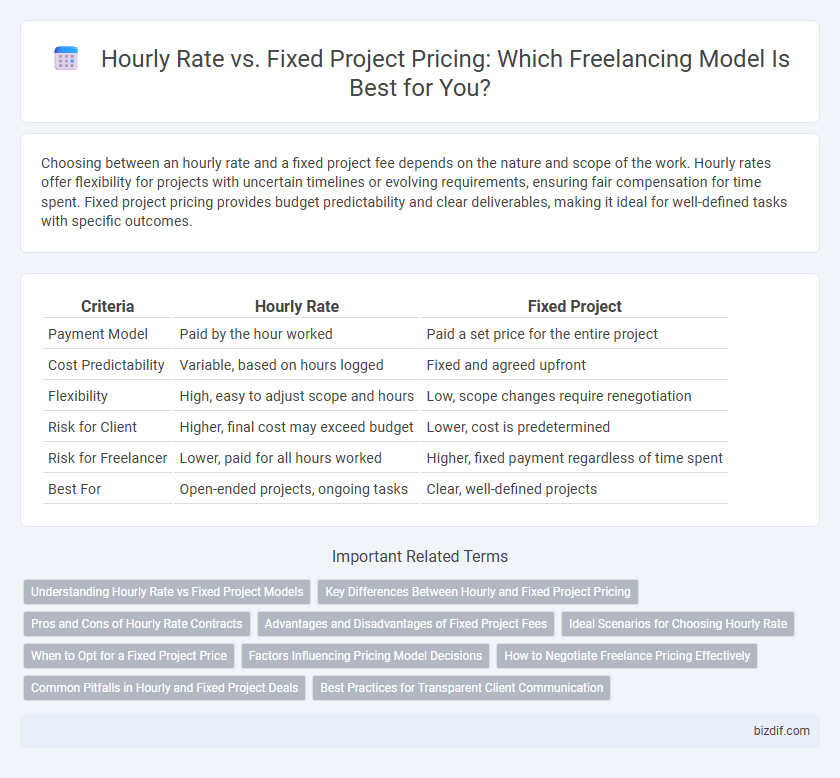Choosing between an hourly rate and a fixed project fee depends on the nature and scope of the work. Hourly rates offer flexibility for projects with uncertain timelines or evolving requirements, ensuring fair compensation for time spent. Fixed project pricing provides budget predictability and clear deliverables, making it ideal for well-defined tasks with specific outcomes.
Table of Comparison
| Criteria | Hourly Rate | Fixed Project |
|---|---|---|
| Payment Model | Paid by the hour worked | Paid a set price for the entire project |
| Cost Predictability | Variable, based on hours logged | Fixed and agreed upfront |
| Flexibility | High, easy to adjust scope and hours | Low, scope changes require renegotiation |
| Risk for Client | Higher, final cost may exceed budget | Lower, cost is predetermined |
| Risk for Freelancer | Lower, paid for all hours worked | Higher, fixed payment regardless of time spent |
| Best For | Open-ended projects, ongoing tasks | Clear, well-defined projects |
Understanding Hourly Rate vs Fixed Project Models
Hourly rate models charge clients based on the exact hours worked, providing flexibility and transparency for projects with evolving scopes. Fixed project models offer a set price agreed upon before starting, ensuring predictable costs and clear expectations for defined deliverables. Freelancers must evaluate project complexity, client preferences, and risk tolerance to choose the optimal payment structure.
Key Differences Between Hourly and Fixed Project Pricing
Hourly rate pricing charges clients based on the exact time spent, offering flexibility and precise compensation for ongoing or uncertain project scopes. Fixed project pricing sets a predetermined total fee for a well-defined deliverable, providing budget predictability and clear expectations for both parties. Key differences include payment structure, risk distribution, and suitability depending on project complexity and client requirements.
Pros and Cons of Hourly Rate Contracts
Hourly rate contracts offer flexibility by allowing freelancers to get paid for every work hour, which suits projects with evolving scopes. This payment model ensures transparent earnings based on actual time invested but may lead to unpredictable income and potential client disputes over tracked hours. Hourly billing encourages detailed time management yet can reduce motivation to complete tasks efficiently compared to fixed project fees.
Advantages and Disadvantages of Fixed Project Fees
Fixed project fees offer clear budget expectations and simplify payment processes for both freelancers and clients, reducing the risk of scope creep and disputes over time spent. However, inaccurately estimated projects can lead to undercompensation for freelancers, especially if unforeseen challenges arise or the project scope expands. This pricing model demands precise upfront project scoping and strong communication to ensure profitability and client satisfaction.
Ideal Scenarios for Choosing Hourly Rate
Hourly rates are ideal for projects with evolving scopes or unclear requirements, allowing freelancers to be compensated fairly for the time spent. This pricing model suits tasks involving ongoing revisions, consultation, or maintenance where workload fluctuates. Hourly billing ensures transparency and flexibility, benefiting both freelancers and clients in dynamic project environments.
When to Opt for a Fixed Project Price
Choosing a fixed project price is ideal when the project scope is clearly defined, deliverables are specific, and deadlines are established upfront, minimizing scope creep and payment disputes. Fixed pricing provides budget predictability for clients and incentivizes freelancers to work efficiently, especially for projects with repetitive tasks or consistent requirements. Opting for a fixed price also benefits complex projects with detailed milestones that require precise planning and resource allocation.
Factors Influencing Pricing Model Decisions
Freelancers choose between hourly rates and fixed project pricing based on project complexity, scope clarity, and client relationship. Hourly rates provide flexibility for evolving tasks and easier adjustments, while fixed pricing suits well-defined projects with clear deliverables and timelines. Factors like risk tolerance, payment security, and administrative overhead also influence the pricing model decision.
How to Negotiate Freelance Pricing Effectively
When negotiating freelance pricing, clearly define the scope of work to determine whether an hourly rate or fixed project fee is more appropriate, ensuring transparency and preventing scope creep. Research industry standards and client budgets to set competitive rates that reflect your expertise and project complexity, establishing value without undervaluing your services. Communicate confidently, justify your pricing with previous work examples and expected deliverables, and remain flexible to adjustments based on client needs while safeguarding your minimum acceptable income.
Common Pitfalls in Hourly and Fixed Project Deals
Freelancers often face challenges with hourly rates, such as underestimating project scope and losing track of billable hours, which can lead to reduced earnings and client disputes. Fixed project deals carry risks like scope creep and unanticipated revisions, causing time overruns without additional compensation. Clear contracts detailing deliverables, timelines, and revision limits help mitigate common pitfalls in both pricing models.
Best Practices for Transparent Client Communication
Clearly defining the scope, deliverables, and payment terms at the start establishes trust and prevents misunderstandings in hourly rate vs fixed project agreements. Providing detailed time logs for hourly work or milestone-based updates for fixed projects ensures clients stay informed and engaged throughout the collaboration. Transparent, frequent communication about budget expectations and potential scope changes fosters a professional relationship and supports timely project completion.
Hourly Rate vs Fixed Project Infographic

 bizdif.com
bizdif.com